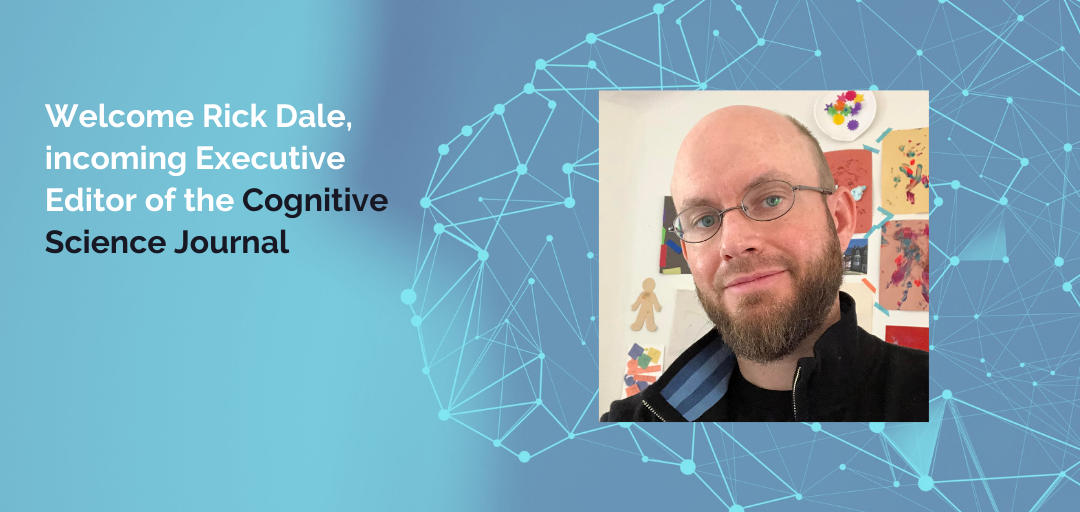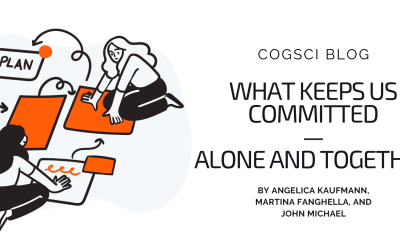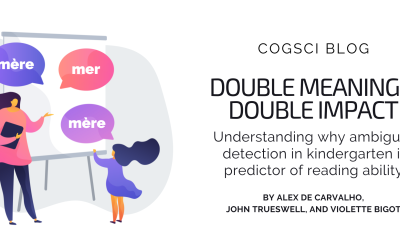The Mindset of Cognitive Science
The aims of Cognitive Science have been passed to us from the ones that inspired its founding, to “transmit the excitement surrounding the paradigm shift in the study of cognition made possible by the synthesis of artificial intelligence, psychology, and linguistics.” (Collins, 1977, p. 2) Our present Author Guidelines, adapted slightly with each editorial iteration, now define the journal as an outlet for the “multidisciplinary study of minds and other intelligent systems … to publish the highest quality articles of multidisciplinary concern on cognition from multiple perspectives, including anthropology, artificial intelligence, education, linguistics, neuroscience, philosophy, and psychology.”[1]
Cognitive science doesn’t just cut across these fields—it also cuts into them. It can challenge, alter, and expand theories in one field by importing elements from others. But who is doing this importing and exporting? Are they cognitive scientists, or members of each distinct field, or both? Do they belong in cognitive science departments or departments of cognitive sciences? I’m inspired by the idea that cognitive science thrives primarily as a scientific mindset that projects its focus outside the space of traditional disciplines. Indeed, if we could point with our fingers to a rigid institutionalization in universities and programs and curricula, cognitive science may have become something else. Similarly, focusing too closely on traditional disciplines gives entrenched administrative structures too much sway on how we think about and connect minds, brains, bodies, communities and cultures.
In this sense, we are a disruptive discipline. Consider some examples. The massively impactful learning sciences were partly conceived in cognitive science. Critical progress on mental and semantic models were sharpened in cognitive science and have impacted many fields. Studies of ecologically embedded cognitive systems have fundamentally shaped human-computer interaction and related domains. And the first Rumelhart Prize winner[2] and his community of neural network modelers have completely transformed the interface among machine learning, AI and industry. Important seeds of these advances and others were all born in cognitive science and, indeed, disseminated in Cognitive Science (inter alia: Ackley, Hinton, & Sejnowski, 1985; Bobrow & Winograd, 1977; Brachman & Schmolze, 1989; Chi, Feltovich, & Glaser, 1981; Dale & Reiter, 1995; Elman, 1990; Gentner, 1983; Hutchins, 1995; Jordan & Rumelhart, 1992; Klahr & Dunbar, 1988; Lakoff & Johnson, 1980; Newell, 1980; Rumelhart & Norman, 1982; Sweller, 1988).
So what kind of science are we, and what kind of journal is this, exactly? I have noticed that one’s favorite philosopher of science is often adduced for these sorts of questions. For example, Lakatos (1970) is a perennial go‐to, cited widely to frame potential progress in research programs. However, neither Lakatos nor any particular framework for science should be taken as normative, as there is no consensus philosophy of science (because it is a vibrant field filled with exciting debate of its own; cf. Schunn, 2019). Cognitive scientists could take a page out of the book of philosopher Feyerabend instead, and proclaim, “The best education consists in immunizing people against systematic attempts at education” (Feyerabend, 1987, p. 316).
This is of course a tongue‐in‐cheek reference to a methodological anarchist. But maybe there is something to it. In some of cognitive science’s early lore, at the Macy Conferences of the prior midcentury, Warren McCulloch served as the meeting’s anti‐disciplinarian hawk by ensuring that its towering attendees like Margaret Mead and Norbert Wiener did not overly respect their own disciplinary boundaries.[3] Our contemporary concerns about disciplinary composition in the field present a new challenge. By overemphasizing disciplinary structures of the past we may obscure possible futures. Still, these structures remain important. There must be a balance between traditional disciplinary diversity and whatever is next for us. We can attend duly to mixing disciplines, but with a healthy skepticism about their reality, too. Here are some ideas about what is next.
1.1 Disciplinary diversity. The future of cognitive science rests in great part with Cognitive Science, and so for the next few years we can continue this exploration together. Surely, disciplinary diversity is critical for our field’s mindset. I resonate with the concern that our multidisciplinary definition may be at risk due to entrenchment of particular research traditions. Psychology has assumed this role, while other disciplines such as anthropology and neuroscience have waned in their representation at the journal (e.g., Cooper, 2019; Gentner, 2010). The concern has prompted some captivating bibliometric laments (e.g., Nuñez, Allen et al., 2019). To address these issues in 2021, the Editorial Board will be joined by two philosophers, two anthropologists, two psychologists who are also cognitive neuroscientists, an expert on human factors and applied cognition. They join continuing Editorial Board members representing many fields, including linguistics, philosophy, education, artificial intelligence, and of course a hearty dose of cognitive psychology. I am lucky to inherit an established and exciting Editorial Board from Rick Cooper, and will continue the trek towards further disciplinary diversification.
We are also lucky to usher in the journal’s inaugural Senior Editorial Board. The Governing Board of the Society, in collaboration with prior Editor Rick Cooper, conceived an intermediate layer of editorial service that would contribute both to the Executive Editor and to the Associate Editors, who will continue to lead primary decision‐making about manuscripts. I have implemented this plan, and we now have four scholars serving as Senior Editors for 2021: Ruth Byrne, Ping Li, Priti Shah and Iris van Rooij. Together they represent an exciting array of expertise and experience spanning neural processes and models to high‐level cognition and education. I am confident with the breadth of expertise and mindset described above, among all our Editors, that Cognitive Science remains open to papers from any field that disrupts and extends our understanding of the mind.
1.2 Diversity, writ large. While attending to this disciplinary diversity, it is also important not to lose sight of other critical dimensions of diversity. These concerns include overcoming biases in geographic representation, ensuring inclusion of scholars from groups traditionally underrepresented in the cognitive sciences, and more. The new Executive Editor of Topics in Cognitive Science Andrea Bender, Past Society Chair Asifa Majid and I devised a new initiative to help expand inclusiveness through what we are calling the Executive Editor’s Outreach Fund (EEOF). Among its goals will be to create outreach materials for high schoolers and undergraduates. The Society will use these funds to support an outreach coordinator who will lead the design and deployment of these materials, focusing on outreach to marginalized communities globally. The EEOF will be overseen by the Diversity Committee of the Society.
1.3. Double-anonymous review process. At the level of journal process itself, another means by which these biases can be mitigated is to adopt a double-anonymous review process. There is, of course, debate about its effectiveness. I’ve noticed this discussion sometimes assumes single-blind review is a default, but I prefer the reverse assumption. Besides forms of bias double anonymity may mitigate (e.g., gender, name recognition), this practice may also encourage authors from varied backgrounds, disciplines and institutions to submit. As a journal aiming for that kind of Feyerabendian boldness mentioned above, author anonymity may encourage both new and seasoned cognitive scientists to do something fresh and daring, because the review process can be relatively encapsulated from the distraction of their departmental affiliations. With Wiley’s help, we are now setup for a fully double-anonymous peer review in 2021.
1.4. Open Materials Policy. I have also instituted a new Open Materials Policy for 2021, now enshrined in the Author Guidelines: “For submissions that include programming code, experimental data, study stimuli, etc., authors are required to share materials so that reviewers gain a clear sense of how a study was conducted, how data were structured and analyzed, how a computational model was implemented, etc. Final, accepted versions of a paper must be accompanied by relevant study materials.” Thanks to many who advised on these matters, including Iris van Rooij, Mike Frank and Asifa Majid. The journal under Rick Cooper already encouraged the sharing of all materials, and in 2021 we can further adopt practices that will help reproducibility, replication and general robustness of our field. But I also see this as relevant to diversity: Sharing our materials widely will help us learn from each other and about each other.
2. What’s next?
I inherit the role of Executive Editor from Rick Cooper, who has offered a devoted 6 years of service to the Society and Cognitive Science. He has seen the journal transform into a digital‐only platform, reduced post‐acceptance publication lag by 67%, and during his tenure he steered a steady course into a flurry of expanding submissions that rose by over 40% from about 280 in 2014 to a record of well over 400 in 2020. I also inherit the journal in great part from Caroline Verdier, who has given many years to the journal and Cognitive Science Society. Her efficient focus and energy have been central to the success of the journal. In 2021, we will shift to management exclusively through Wiley. We will have some new resources under the direct aegis of the publisher (some described above), but it will not be the same in any respect without Caroline overseeing the many moving parts of our journal. I hope that the directions described above, among others, will further contribute to their great work at Cognitive Science.
Finally, let’s playfully return to philosophers Lakatos and Feyerabend, mentioned above [4]. I’ll shamelessly ignore the disciplinary boundaries around my own expertise and discuss them further. I’m keen on the recent discussion regarding plurality in cognitive science (e.g., Bender, 2019). In some past papers, collaborators and I have urged something like it, including in the present journal (e.g., Dale, Dietrich & Chemero, 2009). Lakatos and Feyerabend imply different conceptions of pluralism, a balance perhaps between the institutional integration we’d like to see (Lakatos) but, with it, a preservation of that mindset that projects cognitive science outside of various traditional structures (Feyerabend). In the former, we see an identity materialize into a core of concepts and methods that bring us a common culture (see discussion in Topics in Cognitive Science special topic in volume 11 issue 4: Gray, 2019). In the latter, we challenge even the vertices on Gardner’s hexagon, recognizing that any integrative exercise cannot succeed unless we also heed our originating mindset that disrupts comfortable disciplinary memberships.
This is a tall order for us all, seeking a new coherence through a bit more chaos. I have no special incentives to offer, no new awards or recognitions, the Society has many important ones on offer already (including a new initiative through Topics in Cognitive Science, see Bender, 2021). The changes I mention above (along with a few others not mentioned here) are simple and efficient dials we can turn in hope that our next steps further the success and hard work of those who came before. I’ve deliberately framed this editorial in the most general terms. Cognitive Science is a home for your most daring cross-cutting work. The incentives to do this work will be greater when they arise endogenously, from the mindset of you cognitive scientists.
3. References
Ackley, D. H., Hinton, G. E., & Sejnowski, T. J. (1985). A learning algorithm for Boltzmann machines. Cognitive Science, 9(1), 147-169.
Bechtel, W., Abrahamsen, A., & Graham, G. (1998). The life of cognitive science. W. Bechtel & G. Graham (Eds.), A Companion to Cognitive Science (pp. 1–104). Blackwell Companions.
Bender, A. (2019). The value of diversity in cognitive science. Topics in Cognitive Science, 11, 853– 863.
Bender, A. (2021). A scientific marketplace. Topics in Cognitive Science, 13(1).
Bobrow, D. G., & Winograd, T. (1977). An overview of KRL, a knowledge representation language. Cognitive Science, 1(1), 3-46.
Brachman, R. J., & Schmolze, J. G. (1989). An overview of the KL-ONE knowledge representation system. Cognitive Science, 9(2), 171-216
Chi, M. T., Feltovich, P. J., & Glaser, R. (1981). Categorization and representation of physics problems by experts and novices. Cognitive Science, 5(2), 121-152.
Cooper, R. (2019). Multidisciplinary flux and multiple research traditions within cognitive science. Topics in Cognitive Science, 11, 869– 879.
Dale, R., Dietrich, E. & Chemero, A. (2009). Explanatory pluralism in cognitive science. Cognitive Science, 33, 739-742.
Dale, R., & Reiter, E. (1995). Computational interpretations of the Gricean maxims in the generation of referring expressions. Cognitive science, 19(2), 233-263.
Elman, J. L. (1990). Finding structure in time. Cognitive Science, 14(2), 179-211.
Feyerabend, P. (1987). Farewell to reason. Verso.
Gentner, D. (1983). Structure-mapping: A theoretical framework for analogy. Cognitive Science, 7(2), 155-170.
Gentner, D. (2010). Psychology in cognitive science: 1978–2038. Topics in Cognitive Science, 2(3), 328-344.
Gray, W.D. (2019), Introduction to Volume 11, Issue 4 of topiCS. Topics in Cognitive Science, 11(4), 590-591.
Hutchins, E. (1995). How a cockpit remembers its speeds. Cognitive Science, 19(3), 265-288.
Jordan, M. I., & Rumelhart, D. E. (1992). Forward models: Supervised learning with a distal teacher. Cognitive Science, 16(3), 307-354.
Klahr, D., & Dunbar, K. (1988). Dual space search during scientific reasoning. Cognitive Science, 12(1), 1-48.
Lakatos, I. (1970). Falsification and the methodology of scientific research programmes. I. Lakatos & A. Musgrave In Criticism and the growth of knowledge (pp. 91–196). Cambridge, UK: Cambridge University Press.
Lakoff, G., & Johnson, M. (1980). The metaphorical structure of the human conceptual system. Cognitive Science, 4(2), 195-208.
Miller, G. A. (1953). Review of “Cybernetics: Circular Causal and Feedback Mechanisms in Biological and Social Systems, Transactions of the Eighth Conference” by Heinz von Foerster, Margaret Mead, Hans Lukas Teuber. The American Journal of Psychology, 66(4), 661–663.
Newell, A. (1980). Physical symbol systems. Cognitive Science, 4(2), 135-183
Núñez, R., Allen, M., Gao, R., Rigoli, C. M., Relaford-Doyle, J., & Semenuks, A. (2019). What happened to cognitive science? Nature Human Behaviour, 3(8), 782-791.
Preston, J. (2020). Paul Feyerabend. E. N. Zalta The Stanford Encyclopedia of Philosophy (Fall 2020 Edition), https://plato.stanford.edu/archives/fall2020/entries/feyerabend.
Rumelhart, D. E., & Norman, D. A. (1982). Simulating a skilled typist: A study of skilled cognitive‐motor performance. Cognitive Science, 6(1), 1-36.
Schunn, C. D. (2019). What should cognitive science look like? Neither a tree nor physics. Topics in Cognitive Science, 11(4), 845–852.
Sweller, J. (1988). Cognitive load during problem solving: Effects on learning. Cognitive Science, 12(2), 257-285.
Acknowledgements
Many thoughts in this paper draw inspiration from recent conversations and collaborations with Pablo Contreras Kallens, along with helpful feedback from Asifa Majid and Michael Spivey.
[1] https://onlinelibrary.wiley.com/page/journal/15516709/homepage/forauthors.html
[2] I attended this first Rumelhart Prize talk in Edinburgh as a first-year graduate student. I didn’t quite grasp the massive impact it would yet bring, but you know I thought it was pretty cool.
[3]George Miller (1953) once reviewed the proceedings that emerged from one of these meetings, and his review offers an early and stark description of the challenges posed by multidisciplinarity, “…under the guidance of their ‘chronic chairman,’ Warren McCulloch, some 23 top-notch people talked to each other and a recording machine for two days.” (p. 661) My favorite history of cognitive science summarizes the Macy meetings and much else in a “Life of Cognitive Science” biography: Bechtel, Abrahamsen and Graham (1998, Part 1).
[4] Indeed, the ideas of these two philosophers were apparently exchanged personally, greatly influencing each other as disputants and very close friends (Preston, 2020).



